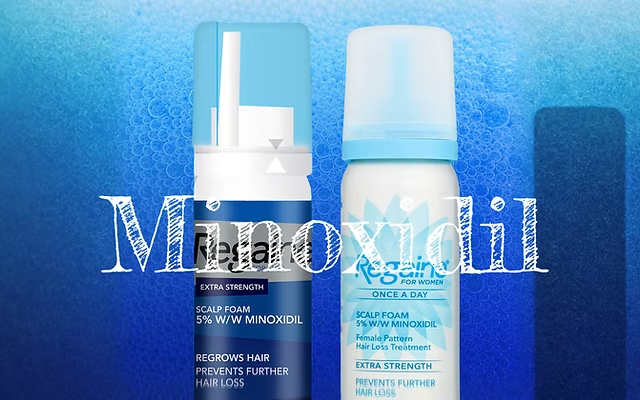Minoxidil is a widely used topical treatment for hair loss in both men and women. Initially developed as an oral medication for high blood pressure, minoxidil gained prominence for its unexpected side effect—hair growth. Today, it is one of the only FDA-approved treatments for androgenetic alopecia (male and female pattern baldness). In this comprehensive guide, we explore minoxidil’s effectiveness, proper usage, side effects, and what to expect from long-term use.
What Is Minoxidil?
Minoxidil is a vasodilator that improves blood flow to the scalp and stimulates hair follicles in the telogen (resting) phase to shift into the anagen (growth) phase. This revitalizes shrunken follicles, leading to thicker and longer-lasting hair growth.
Available in 2% and 5% concentrations, minoxidil can be purchased over the counter as a solution or foam. The 5% version is typically recommended for men, while the 2% version is often suggested for women, although higher concentrations may also be used under medical supervision.
How Minoxidil Works
Minoxidil’s mechanism isn’t fully understood, but its primary effects are believed to include:
Prolonging the anagen phase of hair growth
Enlarging miniaturized hair follicles
Improving blood circulation to scalp tissues
Increasing follicle size and hair shaft diameter
It works most effectively on individuals experiencing recent or mild to moderate hair thinning and is less effective on completely bald areas.
Who Should Use Minoxidil?
Minoxidil is suitable for:
Men with male pattern baldness (MPB), especially in the crown area
Women with female pattern hair loss (FPHL)
Individuals with alopecia areata (in some cases)
Those seeking to improve beard density or eyebrow thickness
It is not recommended for people with sudden or patchy hair loss unrelated to genetic causes, or hair loss resulting from medications, childbirth, or nutritional deficiencies.
Types and Forms of Minoxidil
1. Minoxidil Solution
Comes in 2% and 5% concentrations
Contains propylene glycol, which can sometimes irritate the scalp
Requires twice daily application
2. Minoxidil Foam
Easier to apply and dries faster
Ideal for users with sensitive skin
Typically applied once or twice daily
3. Oral Minoxidil (Off-label Use)
Low-dose oral tablets prescribed by dermatologists
Effective in some cases, but may carry systemic side effects
Choosing between these depends on personal tolerance, area of application, and desired convenience.
Proper Application of Minoxidil
Step-by-Step Instructions:
Ensure the scalp is clean and dry before application.
Use the dropper (for solution) or foam cap (for mousse) to apply directly to the affected area.
Gently massage the product into the scalp with fingertips.
Allow to dry completely before applying other hair products.
Wash hands thoroughly after use.
Consistency is crucial—missed doses can impact effectiveness. Results typically begin to show after 3 to 6 months of regular use.
Expected Results and Timeline
Hair regrowth with minoxidil varies between individuals. A general timeline is as follows:
Month 1-2: Shedding may increase. This is temporary and a sign the treatment is working.
Month 3-4: Fine vellus hairs start to appear in thinning areas.
Month 6-8: Noticeable thickening of hair, improved density.
Month 12: Full results usually observed.
Continued use is required to maintain results. Discontinuation leads to gradual loss of regrown hair.
Side Effects of Minoxidil
While minoxidil is considered safe for most users, some may experience:
Scalp irritation or dryness
Flaking and redness
Unwanted facial hair growth if it comes into contact with other areas
Initial shedding in the first few weeks
Rare systemic side effects may include:
Rapid heartbeat
Swelling in hands or feet
Weight gain
Dizziness
These usually occur with oral minoxidil or overuse of topical formulations.
Precautions and Interactions
Before using minoxidil:
Consult with a dermatologist if you have scalp conditions, heart disease, or are pregnant/breastfeeding.
Avoid combining with other topical treatments unless advised.
Do not apply to broken, irritated, or sunburned skin.
If irritation persists or adverse effects occur, discontinue use and seek medical advice.
Tips for Maximizing Minoxidil Effectiveness
Be consistent: Use as directed, without skipping doses.
Use a derma roller: Microneedling can enhance absorption and follicle stimulation.
Maintain a healthy diet: Ensure adequate intake of iron, vitamin D, zinc, and protein.
Avoid stress: Chronic stress can worsen hair loss and counteract benefits.
Limit harsh styling: Minimize heat tools and tight hairstyles that stress follicles.
These habits, in combination with minoxidil, can accelerate and sustain hair restoration.
Comparing Minoxidil to Other Hair Loss Treatments
| Treatment | FDA Approved | Ideal For | Pros | Cons |
|---|---|---|---|---|
| Minoxidil | Yes | Men & Women | Easy application, effective for many | Requires ongoing use |
| Finasteride | Yes (men only) | Male pattern baldness | Oral use, reduces DHT | Sexual side effects |
| Hair Transplant | N/A | Advanced hair loss | Permanent solution | Expensive, surgical |
| Laser Therapy | No (varies) | Thinning hair | Non-invasive | Inconsistent results |
| Natural Remedies | No | Mild hair thinning | Low risk | Limited scientific backing |
Minoxidil remains a first-line, evidence-backed treatment for many seeking non-invasive options.
Frequently Asked Questions
Q: Can I use minoxidil on my beard?
A: Yes, many use minoxidil to enhance beard growth, although this is considered off-label use. Results vary by individual and should be monitored closely.
Q: What happens if I stop using minoxidil?
A: Any regrown hair will likely be lost within 3 to 6 months after stopping the treatment.
Q: Can I use minoxidil with finasteride?
A: Yes, combining the two often results in superior regrowth, especially in men with aggressive hair loss.
Q: How long should I use minoxidil?
A: Indefinitely, if you want to maintain results. Stopping treatment typically reverses the benefits.
Conclusion
Minoxidil is a scientifically supported, affordable, and easily accessible solution for managing hair loss. Whether you’re dealing with early thinning or hereditary baldness, incorporating minoxidil into your routine offers a realistic path to regaining hair density and confidence. For best results, use consistently, monitor progress, and consult a healthcare professional for personalized advice.


















